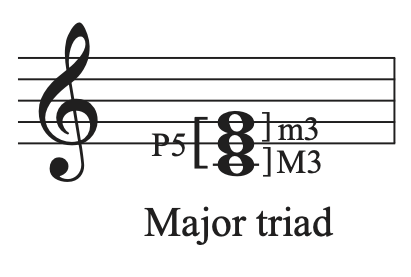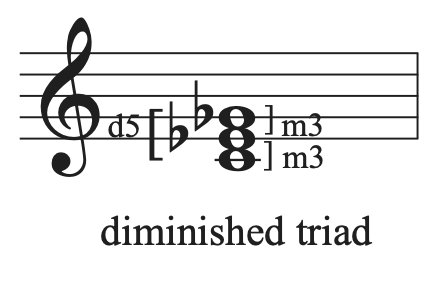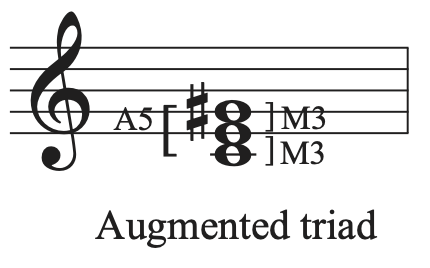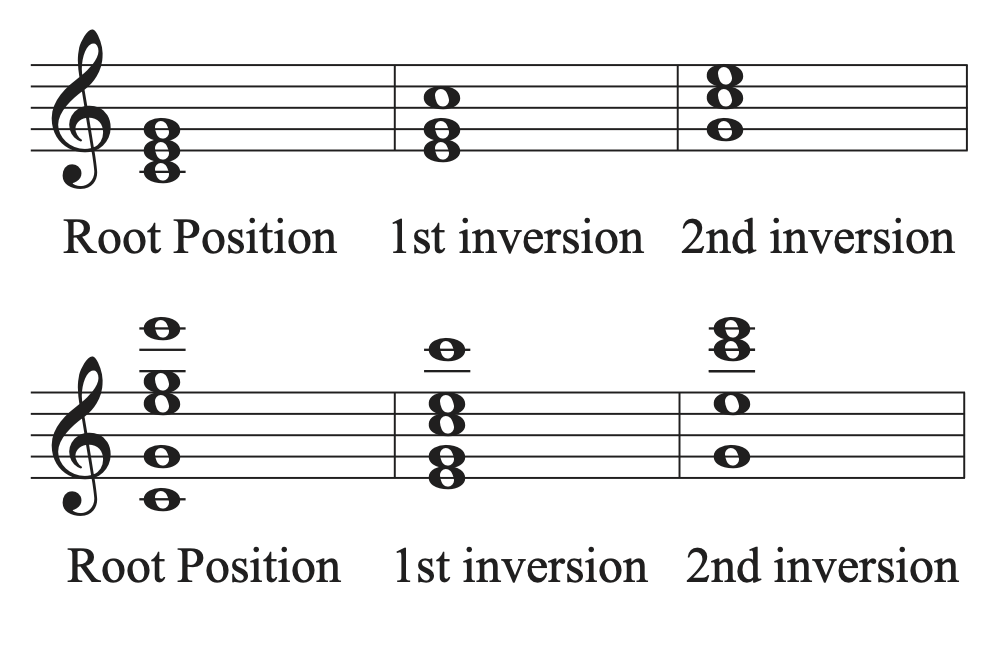5.1 Triads and Inversions: Tutorial
Triads
A chord is made up of 3 or more pitches sounding together. Three note chords built from thirds are called triads. Triads are the fundamental harmonies used in major and minor keys. There are four types of triads, each built with a specific combination and order of either major or minor 3rds.
The Major Triad
The major triad is built starting with a major 3rd on the bottom, followed by a minor 3rd on top. Its outer interval forms a perfect 5th, which helps to give it a stable sound. Major triads are used frequently in music.

The Minor Triad
The minor triad is built starting with a minor 3rd on the bottom, followed by a major 3rd on top. Its outer interval also forms a perfect 5th, which helps to give it a stable sound. Minor triads are used frequently in music.

The Diminished Triad
The diminished triad is built from stacking two minor 3rds. Its outer interval is a diminished 5th, which gives it its name. The diminished 5th interval is dissonant and unstable. It creates forward motion towards a resolution in the chord that follows. Diminished triads are naturally occurring in both major and minor keys, but are not used as frequently as major and minor triads.

The Augmented Triad
The augmented triad is built from stacking two major 3rds. Its outer interval is an augmented 5th, which gives it its name. Like the diminished 5th interval in the diminished triad, the augmented 5th interval is dissonant and unstable. Augmented triads are not naturally occurring in any major or minor key. In order to form an augmented triad, accidentals outside of the key signature must be used.

Naming Chord Members
Each chord member is given a name based on its position in the chord. When the chord is stacked in its most close position, the lowest sounding member of the chord is called the root. That is the scale degree on which the chord is built. The middle chord tone is called the 3rd because it sits a 3rd above the root, and the top member of the chord is called the 5th because it sits a 5th away from the root of the chord. It is important to remember that while it is easiest to quickly determine the root, 3rd, and 5th of a chord when its stacked in its most close position, chords can be written with the notes in any position. The notes that are the classified as the root, the 3rd, and the 5th of the chord will not change no matter where they are located on the staff in relation to one another.

Triad Inversions
The lowest sounding pitch in a chord determines the inversion of a chord. Triads, because they contain 3 pitches, have 3 possible inversions.
- When the root of the chord is the lowest sounding member of the chord, the chord is in root position.
- When the 3rd of the chord is the lowest sounding member of the chord, the chord is in first inversion.
- When the 5th of the chord is the lowest sounding member of the chord, the chord is in second inversion.
The upper member of the chord can be in any order on the staff without changing the inversion. When analyzing music chord labels include the root, quality, and inversion of the chord.

Root position chords are the most stable inversion because the root of the chord is the lowest sounding member. Triads become more unstable as they progress from first inversion to second inversion. Root position and first inversion triads occur most frequently in music and can generally be substituted for one another. Second inversion triads are special and serve as embellishing chords. They decorate other chords and can’t be substituted for root position and first inversion chords. Second inversion chords are used less frequently in music than root position and first inversion chords.
Analyzing Triads in Music
Analyzing music requires decision making and attention to detail. It is often possible to interpret passages in different ways and come up with different analyses. That’s what makes theory fun! As you learn more about how music work you will have a better understanding for why one choice might be better than another in an analysis. Here are the basic steps to follow when analyzing music:
First, stack the notes in 3rds so that you can find the root of the chord.
- Eliminate any double notes.
- Makes sure to look at the key signature so you don’t miss any accidentals that should be included with the chord.
- Make sure to look carefully at the rhythm so that any notes that are still sounding and were held over from previous chords can be included in your analysis.
- Figure out where the chord changes and make sure that all notes before the chord change are included with the chord. You know a chord changes when new notes appear that do not fit in the current chord, or when the bass pitch changes.
- Eliminate any pitches that are not chord tone. Non chord tones will be decorative pitches that are not part of the main chord and cannot be stacked into the triad. You can exclude those from your analysis.
- Fill in missing chord members if a triad is not complete. Not all chords will contain all notes. In order to have a triad, you need the root in order to establish the chord. The 3rd of the chord is most often included because it determines the quality of the chord. If a chord member must be omitted, the 5th is typically the chord member chosen. Any chord member that is omitted can be imagined as part of the chord, using the given key signature.
After determining which notes are chord members, and having stacked them in 3rd, analyze the quality of the triad (Major, minor, Augmented, or diminished).
Then, look at the inversion of the chord to determine if the chord is in root position, first inversion, or second inversion. Include the root, quality, and inversion in your labels.
Look at the following example and analyze the triads found in the score.

This example shows the score work that was done, following the guidelines listed above, in order to analyze the triads.

Look at the music you are currently practicing or studying. If you are playing a piece that has more than one part or line, can you stack the notes into thirds to find and identify triads? Did you find any chords that have more than three notes? We’ll talk about how to identify those in later chapters. For now, simplify them into triads to analyze them. How often are root position chords used in comparison to first inversion and second inversion chords in your music? If you are playing a piece with only one part, can you find instances where triads are implied through chord arpeggiations in the music? We find chords used in music both vertically as part of the harmony, and melodically as components of the melody.

